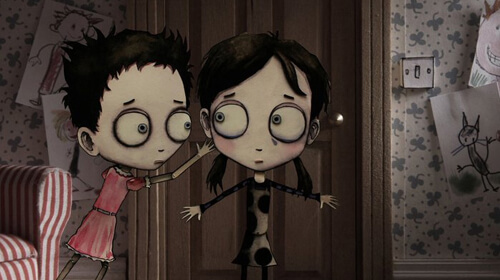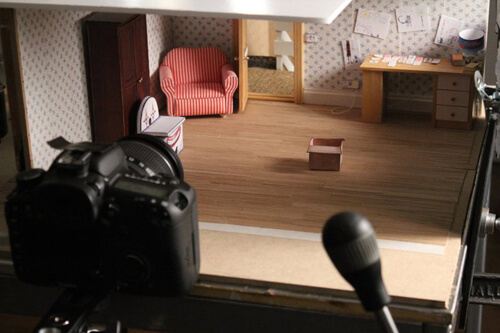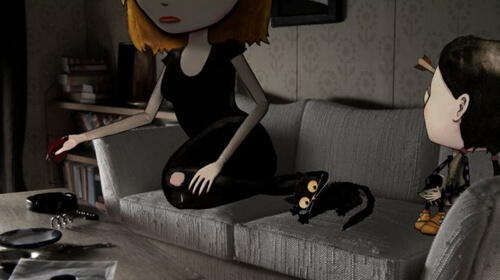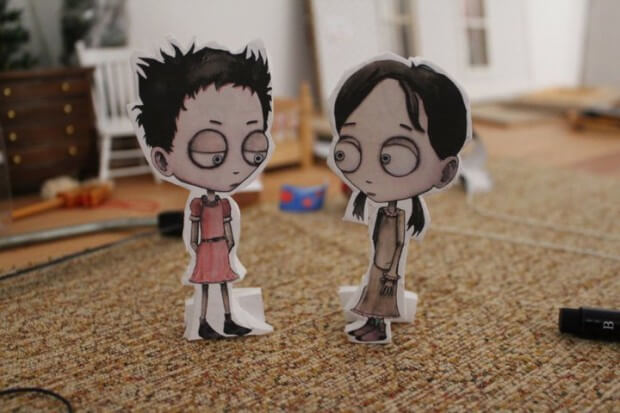Being Bradford Dillman: An Interview with Emma Burch
You may have already heard of Being Bradford Dillman, the highly anticipated film which has been creating waves in the film festival circuits. Indeed, to date it has been selected for over 65 international festivals and can already boast itself winner of 7 prestigious awards which include: the Gold Award at USA’s Prestige Film Awards, the Excellence Award at Rincon International Film Festival, Best Short Animation at High Deserts Film Awards, USA and an Honourable Mention at the Metropolitan Film Festival in New York.
The film itself follows a curiously dark story of a little girl called Molly Flowers and her misguided journey of self exploration. Its visual style, which combines cut out stop motion characters composited into a model world gives the film a unique distinctiveness despite its small budget. Its gritty, earthy textures and dark tones are reminiscent of the work of such cinematic visionaries Tim Burton and David Lynch. Although it may not perhaps be a film for children Being Bradford Dillman effectively captures the naïve curiosity and limitless imagination that comes as part of being a child. Interestingly, it also suggests how these traits can still be explored as an adult, as the self medicated mother demonstrates, although to more harmful effects…
The film was created by illustrator Pete Williamson and producer Emma Burch. Animation producer Burch began her career in the industry as a runner at Loose Moose before progressing to producer for the company where she remained for ten years. Supported by Glenn Holberton at Loose Moose, Emma began work on Being Bradford Dillman whilst with the company and joined Seed Animation as an animation producer once the production was complete. Nowadays, Emma continues to work as a producer and content editor at Tandem Films, along with promoting the film. We caught up with her to discuss Being Bradford Dillman’s production process, distinctive style and unusual subject matter…
You graduated with a degree in Contemporary Media Practice from the University of Westminster. Was it always animation that interested you? Could you describe how you got started in the industry?
The CMP degree covered all areas of media. It meant I came out a bit a Jack of all trades and wasn’t really sure what I wanted to do after. I had also fallen quite far behind on the course due to having quite a few family deaths by the end of my second year. University attendance finished but I still had my dissertation to submit – and bills to pay! I went through the motions like so many graduates of sending out numerous CVs and knocking on doors and was just so lucky to land a Runner job at Loose Moose. At the time, they weren’t that busy and let me write my dissertation when it was quiet. I have Glenn Holberton to thank for completing my degree, among many other things! I quickly working my up as Producer and stayed at Loose Moose for 10 years as it was such a family environment. I watched and learned from some very talented people. It was quite early on at Loose Moose where I realised I had a true passion for animation. Mainly because it’s such a great industry to work in.
Being Bradford Dillman reportedly took ten years to make. Although it has been worth the wait, why did it take so long?
It started as just an exercise for Pete Williamson and I to keep our own creative juices flowing. When we started I was a production assistant and Pete was Loose Moose’s main designer. We were working on commercials but wanted to create something without commercial restrictions. We used to get together after work with a bottle of wine and develop the story. After a couple of years we applied for funding and was shortlisted but unfortunately didn’t make the final list. Animation is expensive and because neither of us are animators – it made it quite hard to get off the ground! We had a fully developed script and character designs for a couple of years before Daniella Orsini sent in her reel and showed us a way to make it relatively economically. When Glenn committed to funding production I felt I couldn’t let him down and really gave it my all for 12 months. Film making is hard work, especially due to the lack of funding available but it can be so rewarding.
As a producer at Tandem Films was it difficult to juggle working on the film, which I imagine feels like a personal project to you having co-wrote it, with your other work at the company?
It was really tough for the first few months as I wasn’t giving it the amount of attention I wanted too. I had already spoken to Glenn about me moving on from my Producer role and decided to give up work to concentrate on the film full time. Luckily my boyfriend Chris was very understanding and supported me through production. It was a big lifestyle change and potentially not a very healthy one but one I don’t regret for a second. Things have gone back to normal now.
Without giving too much away to people who have not seen the film, it follows a rather dark story of a girls understanding of her self and her world. How did the story come about?
It’s heavily influenced by both mine and Pete’s childhoods, with the main premise of Molly being told she was born a boy being directly lifted from mine. When I told Pete my mum had told me that when I was 3 and that I believed it till the age of 6 he found it really interesting. I had been telling the story for years and would always receive really extreme reactions. People either found it hilarious or absolutely shocking that a mother would tell her child such a lie. Children are very trusting of the adults around them and sometimes I think adults underestimate how clear headed and smart kids can be. I’ve always felt quite strongly about how wrong it is when adults assume children have an inferior ability to understand the world around them, especially with difficult relationships and things like drink and drug dependancy. When in actual fact it’s usually adults that have things all messed up because their relationships are far more complicated and their expectations far higher than a child’s. Being Bradford Dillman tries to look at the role reversal of parent and child and how much influence a parent can have without intentionally doing so.
What is it about animation that you feel makes it able to tackle dark and difficult issues so effectively?
I think it can soften the edges to difficult subjects that some people might usually find to too awkward or upsetting to watch.
The film has a unique style which combines cut out stop motion in a real world setting. What inspired you to combine these two forms and create such an original style?
I probably shouldn’t admit it but it was one of those ‘happy accidents’. Originally we planned to shoot the film with 100% cut outs using Daniella’s multiplane set up and Pete’s illustrations. We wanted the backgrounds to be desaturated but hadn’t accounted for every layer of glass adding a green hue. Professional multi plane glass is quite expensive so we quickly realised it wasn’t going to be possible on our budget. To keep production moving we decided to shoot the characters against green and I would figure something out. I was thinking of using photographs but sourcing the right locations was going to be very difficult! It was then Charlotte Blacker, the films animation assistant, suggested dolls house furniture. I realised it would fit perfectly with the style of the film. I specifically picked items that had a realistic scale to them but also had a certain element of children’s toy about them. It also meant I could create the sets myself without incurring too much of a cost. I was really happy with the way it turned out.
Were there any restrictions you faced using this form of animation?
The whole process was a huge learning curve for me. As much as the dolls house sets were a great idea, I hadn’t anticipated how much work it would create for Peter Ellmore, the DoP. He had to convincing light a set that was at 12:1 scale. It was very fiddly but I think he did an amazing job and every room feels like it’s full scale with really believable lighting.
The mother in the film is always shot with her face out of view, why did you feel it better to make her identity ambiguous?
We didn’t want the film to be too much about the mum. She has her own background and fascinating story to tell and we thought by restricting her face her face, the audience could remain focused on Molly. It also helped reduce the amount of facial animation Daniella had to shoot!
The illustrative style pushes the notion of cute to an extreme with the large heads and oversized eyes, was this a conscious decision and were you inspired by any other films or animators?
At the time it was Pete’s illustration style, which I have always loved. He has said to me that he – “… wanted to take cuteness and push it in an extreme way that became unsettling—children with large unwieldy heads and enormous eyes that seem to have seen too much of the world. In a way I was trying to subvert the appeal of the design work I was doing for commercials, and create something darker and stranger” I think he did that perfectly.
What is next for you post-Being Bradford Dillman?
At the moment I’m working as a freelance producer and have the honour of helping out on Daniel Greaves latest film ‘Grey Area’ which is really exciting. It features plasticine characters which is a new medium for me. I’m learning every day there which is great. Since BBD I have been contacted to work on other collaborations which I hope take off. One is a short called Bruises with New York based writer Kelvin Bias. And the BBD team has a feature length idea that would see Molly make a real life friend – which is extremely ambitious but something I’m REALLY excited about.
Visit The Being Bradford Dillman Facebook page here





